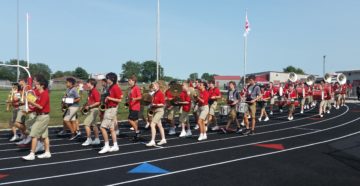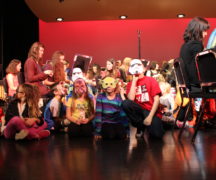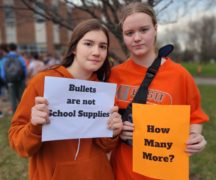By JAN LARSON McLAUGHLIN
BG Independent News
Parents with high school daughters know the drill. Before the teens leave for school, they have to pass the fingertips test.
“I check every morning,” said Shari Beeker, who has two daughters at Bowling Green High School. “Do your fingers go below your shorts?”
So far, Beeker’s daughters haven’t had a problem. But others have not fared so well.
As is customary for the beginning of the school year, some students are testing the boundaries of the high school dress code. And this year, some parents are suggesting that it’s difficult to find teenage clothing that meets the dress code criteria.
So Bowling Green Superintendent Francis Scruci is looking for 20 high school staff, parents and students to be part of a Dress Code Task Force, to review, discuss and perhaps make changes to the current policy. Scruci sent out emails to all high school parents asking those interested to contact him.
Part of the problem may be that the high school is not air conditioned – so some students wear as little clothing as possible. But Scruci suggested some common sense is needed.
“Everybody is still dressing like it’s summer,” Scruci said last week. “It’s got to become common sense.”
High school principal Jeff Dever said the dress code may need some tweaking. But overall, it’s reasonable.
“No one should see bra straps and parts of rear ends,” Dever said.
“I don’t think it’s outdated. Some of the parents think they can’t find clothes that meet the dress code,” he said. “I just think we have to set expectations. We’re getting kids ready for the workplace.”
Dever expects the issue to cool down once the weather cools down and students become familiar with the expectations.
Dever, who has been principal at Bowling Green High School for 19 years, said it used to be the boys’ clothing that was a problem. Boys wearing shirts with beer labels or other inappropriate language were required to change clothes or were sent home.
Now it’s primarily the girls’ clothing that is the issue.
“When I see underwear, we’ve got to do something about it,” Dever said.
“Those are in vogue now,” he said about short shorts. But they aren’t appropriate attire for school.
Listed among the improper attire in the student handbook are: hats, dog collars, chains, extensive piercings, tank tops, and leggings without cover-ups at least fingertip length. The student handbook also states hair coloring must not be “extreme, distracting or disruptive (blue, pink, etc.)” But Dever said there are no longer any hair color restrictions.
Jo Ann Schempf said her daughter talked about the dress code when she came home during the first week of school.
“My daughter said, ‘They don’t make shorts that long,’” Schempf said. Her main concern, however, was about the sports uniforms and her band majorette uniform – which are clearly in violation of the rule.
However, athletic uniforms aren’t covered by the school dress code – which is only for apparel worn during the school day, according to Board of Education President Ellen Scholl.
Scholl said that while she supports the existing dress code, she has no problem with it being reviewed and modified if needed. “I’m happy with it the way it is. But we always need to look at it to see if it fits the needs of the community.”

BGHS marching band performs at Fan Fair event.
The marching band shorts comply with the dress code, since they almost stretch to the knees. However, few students are going to wear those to school, according to Cathy Cable, whose daughter is a senior in band.
“That’s the problem. Nobody wants to wear those,” she said.
The beginning of the school year may be a bit rocky for some students and their clothing choices because of inconsistent enforcement.
“Quite honestly, I think it is a problem because they didn’t enforce it for several years,” Cable said.
Beeker has also heard that the enforcement is not consistent with all students.
“I think a little more explanation would be helpful,” she said. “I think it needs tweaking.”
Yvonne Rose, whose daughter is a junior, said she is hearing the same complaints.
“It seems biased against young ladies. So the girls are really thinking it’s unfair,” she said.
Rose’s daughter goes to school each day prepared with a sweater – just in case her top is found to not comply with the dress code.
But the sweltering temperatures in the high school don’t help, some parents said.
“As hot as it is, with no air conditioning – you can’t go in and be productive,” if students are too overheated in the classrooms, said Jackie Emans, whose daughter is a senior.
Following is the dress code as it appears in this year’s student handbook:
DRESS CODE
In general, the Board believes that school dress should be such that it ensures the health, welfare and safety of the members of the student body and enhances a positive image of our students and the schools. Any form of dress or grooming, which attracts undue attention or violates the previous statement, is obviously unacceptable. The student will receive unexcused absences for each class they miss correcting the Dress Code violation.
Requirements include:
- Dress and grooming standards require cleanliness in the interest of health, sanitary conditions and safety requirements.
- When a student is participating in school activities, their dress and grooming will not disrupt their performance or that of other students or constitute a health threat to themselves or other students.
- Dress and grooming will not be such as to disrupt the teaching-learning process. Part of a student’s total education is learning to dress appropriate and behave responsibly in a variety of situations. Research has shown a correlation between appearance and behavior, especially in a school setting.
Attendance at school and school-related functions is a specific situation that requires students to use good judgment. Bowling Green City School District students will dress in a manner that is appropriate to the school environment and in a way that does not cause disruption to the academic process. The following guidelines will assist parents, students, faculty and administrators in determining appropriate dress code standards for students attending school or school-sponsored activities.
General Guidelines:
- Students, under parental supervision, maintain responsibility for their dress and personal appearance.
- The Board of Education prohibits any dress or grooming that interferes with the cleanliness, health, welfare or safety of students or that disrupts the educational process by being distracting, indecent or inappropriate to the education process.
- Sponsors and teachers of elective classes (such as vocational and arts classes) or elective activities (such as sports) may require more strict standards regarding dress and appearance for participants in their programs or activities.
- Principals, with the assistance of faculty, are responsible for uniformly administering the dress code. A principal’s decision is final.
- The Board of Education reviews and modifies this policy annually to remain aligned with new fashion trends or dress accepted by the Bowling Green community.
SPECIFIC GUIDELINES:
Grooming Standards:
- Hair must be clean, worn out of the eyes, and groomed at all times. Hair coloring and/or hair styles must not be extreme, distracting or disruptive (blue, pink, etc.)
- Makeup must not be extreme or distracting.
Clothing Standards:
- Shorts and skirts must extend to finger-tip length.
- Students must wear shoes at all times. Slippers/bedroom shoes are not to be worn. All elementary students (K-6) must wear shoes with backs or straps and closed toes.
- Shirts/blouses must not be low cut, off the shoulder or otherwise revealing. The following garments are not acceptable or permitted: tube tops, halter tops/dresses, strapless tops/dresses, backless tops/dresses, or tops/dresses which reveal the midriff and/or breasts.
- Clothing may not be “see-through”. Shirts must be worn at all times and must be sized appropriately so that they do not interfere with normal school activities.
- Lower garments are to be worn at waist level; if a belt is to be worn, it must be of proper length; undergarments are not to be exposed.
- Students may not wear:
- (Or carry) hats, coats, bandannas, headbands, sweatbands, or sunglasses to class.
- Piercings that are extreme, distracting, or present a safety hazard.
- Tank tops or muscle shirts.
- Clothing that contains or promotes hate, violence, profanity, vulgar, or negative messages.
- Clothing that promotes, advertises, or relates in any way to the use of alcohol, tobacco, or drugs.
- Clothing that contains sexually explicit or implicit language or pictures.
- Biking pants without a cover-up.
- Spandex clothing including leggings without a cover-up to at least fingertip length.
- Tattered clothing that reveals undergarments.
- Dog collars worn as jewelry.
- Spiked jewelry of any kind.
- Chains.
- Gang or cult-related clothing and/or other items.
- Hoods on sweatshirts worn up during school hours.





